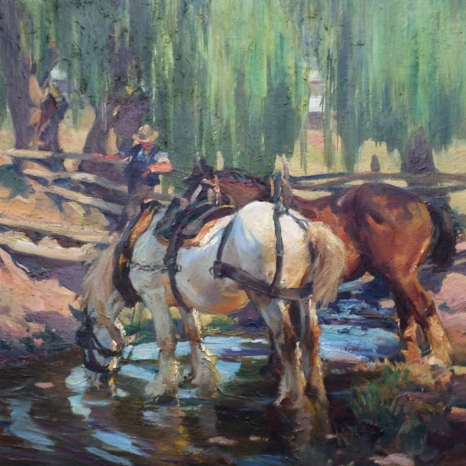Harold Septimus power
(1878 - 1951)
During the First World War Harold Septimus Power captured some of the last significant horse battles to take place in modern warfare in the paintings he created for the Australian War Memorial. He was considered to be the Antipodean Munnings or Stubbs and was held in great regard by Lucy Kemp-Welch. in fact Power spent time with Kemp-Welch at the Bushey School of art when he came to England in 1907.
Power's father was a hatter by trade but also a painter and art teacher; however, despite his son's obvious artistic ability and interest, he strongly discouraged him from pursuing a career as a professional artist. At the age of 14, Power ran away from home to pursue a career as an artist. He developed a passion for drawing animals, especially horses, and found jobs that involved contact with animals. While working for a carriage painter, he painted studies of animal heads on butcher's delivery vans, and later on he worked as a veterinarian's assistant.
In 1900 Power moved to Adelaide where he worked as a political cartoonist with the Register, and painted in the Adelaide hills with Hans Heysen. In 1903 Power was the first Australian artist to receive a commission from the National Gallery of South Australia. In 1905 he travelled to Europe to study at the Academe Julian in Paris. Power eventually moved to London, where he was able to indulge his passion for animal painting with commissions from wealthy English patrons, and he regularly exhibited at the Royal Academy throughout his career.
In 1917, Power was appointed an official war artist with the rank of honorary lieutenant and attached to the 1st Division Australian Imperial Force (AIF). He worked in France from September to December. He was commissioned for a second time from August 1918 to March 1920, and then contracted on commissions for the Australian War Records Section until 1938.
A number of Power's commissions were for large paintings depicting significant campaigns of the Australian Light Horse during the First World War, including Leaders of the Australian Light Horse in Palestine, 1918 and Ziza. In 1922 the Melbourne Public Library commissioned a large mural depicting the Middle Eastern Theatre and the Western Front. In 1927 the Commonwealth selected Power to depict the opening of Parliament in the new Commonwealth building in Canberra. The painting, Opening of Federal Parliament at Canberra, 9 May 1927, is now held in the Parliament House Art Collection.
